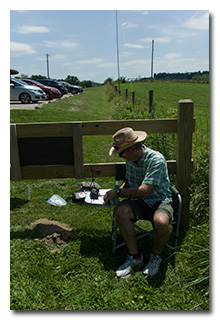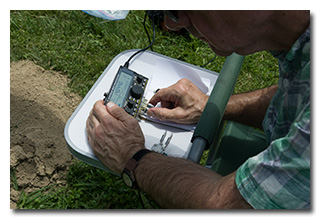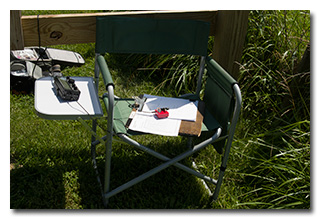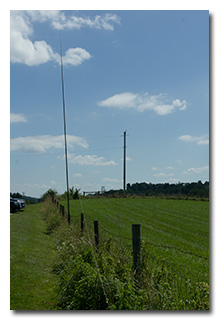
by William Eric McFadden
From the nature preserve's website:
-
Rockbridge Natural Bridge originated millions of years ago, when Ohio lay under a warm inland sea. Rivers flowed into the vast body of water, carrying both fine and coarse grained sands which settled to the sea bottom. Over the centuries, the accumulating sand thickened, compressed and formed the hard sedimentary rock known as Black Hand sandstone. Eventually, great pressure from beneath the earth's surface caused the land in eastern North America to rise, forming the Appalachian Mountains. The inland sea soon drained away, exposing the newly uncovered rock layers to steady erosional processes. The natural bridge soon began emerging in all its grandeur. Wind, rain and percolating groundwater worked together for centuries, carving a deep cave-like recess in the softer midportion of the Mississippian Black Hand sandstone. Gradually, erosional forces also worked along a natural joint plane some distance behind the brink of the cliff. Over the centuries, this ongoing process has widened the crevice, and all that remains of the overhanging ledge is the narrow rock arch.
Pictures
Description
On Friday, June 28, 2024, one member of the Southeast Ohio Radio Adventure Team performed a successful activation of Rockbridge State Nature Preserve in Ohio as part of the Parks on the Air (POTA; link) program.
Following a successful activation of Lake Logan State Park (link) with Len Touth, W8VQ, and a nice lunch at the Lake Logan Diner, Eric McFadden, WD8RIF, and Len drove to Rockbridge State Nature Preserve to perform Len's third-ever POTA activation. They were accompanied by Eric's little dog, Theo.
Because dogs are not allowed within Ohio State Nature Preserves, Len and Eric were unable to hike into Rockbridge State Nature Preserve for their operations, or to see the actual rock bridge. Instead, they set up their stations at the trailhead adjacent to the parking area. Because HF propagation conditions had worsened since their earlier activation of Lake Logan State Park, Eric again deployed his biggest field-portable antenna, his homebrew 40m end-fed halfwave (EFHW) antenna, sloping it up to the top of his 31' Jackite telescoping fiberglass mast strapped to a fence post. As at the previous activation, Len operated first, but this time he chose to use Eric's Elecraft KX2 instead of his own 40m TAC-1 transceiver. Len was on the air about 1800 UTC.
As at his previous activations of this park, Eric had good cell-signal and would be able to spot Len and himself on POTA Spots (link) and to use POTA Spots to identify possible park-to-park (P2P) QSO opportunities.
Len started out on 40m using his own portable iambic paddle, but switched that paddle out in order to try Eric's Elecraft KXPD2 paddle mounted on the KX2. HF conditions turned out to be very poor, and QSOs came very slowly for Len. Because of this, and because there was no shade whatsoever to be had at the trailhead or in the parking lot, and since the temperature had climbed up into the 90s, Eric eventually used his Elecraft KH1 and a dummy load to give Len P2P QSOs on all the bands the KH1 provides, 40, 30, 20, 17, and 15m, finishing the last of these QSOs at 1841 UTC.
With Len having successfully validated his activation, Eric took over the KX2, swapped the key out for his preferred Whiterook MK-33 single-lever paddle, found a clear frequency on 40m to run, began calling "CQ POTA", and was auto-spotted on POTA Spots. Already having logged five QSOs with Len, Eric needed only five more QSOs to validate his own activation. However, 40m was not to provide all of these QSOs. At 1847 UTC, Eric managed to complete a QSO with W9AFB in Wisconsin, and at 1848 UTC he completed a QSO with is friend Brian, K3ES, in Pennsylvania. After these QSOs, nothing...
After checking POTA Spots, at 1854 UTC Eric completed a P2P QSO on 20m with WB0RLJ who was activating Chalco Hills State Recreation Area (US-4011) in Nebraska.
Finding himself a clear frequency on 20m to run, Eric began calling "CQ POTA" and was reassured to see himself auto-spotted on POTA Spots. His first QSO in this run came at 1901 UTC with N0TOP in Missouri. This was followed at 1903 UTC by a QSO with K1RIF in Massachusetts, and at 1904 UTC by a QSO with AC0MP in Missouri.
Having validated his activation with ten QSOs (plus one), Eric finished his operation by hunting for P2P QSOs. At 1908 UTC, he completed a P2P QSO on 20m with WI5D who was activating Harriman Hill Access State Conservation Area (US-11373) in Missouri. At 1910 UTC he completed a P2P QSO on 20m with KW5CW who was activating Eisenhower Birthplace State Historic Site (US-6553) in Texas. At 1913 UTC, he completed a P2P QSO on 20m with AA0AW who was activating Pattison State Park (US-1469) in Wisconsin. Finally, at 1918 UTC, he completed a P2P QSO on 20m with K1BX who was activating Nansen Wayside State Park (US-2668) in New Hampshire.
In all, Eric managed to make fifteen QSOs, with ten P2P QSOs. All of Eric's QSOs were CW and were made with five watts output.
(return)



